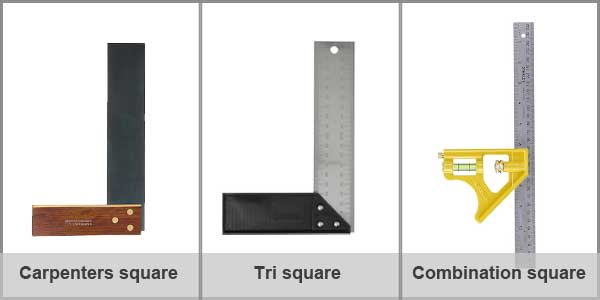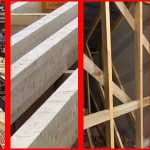Over the years, a carpenter will build up a large collection of tools. This will usually start with basic hand tools, that will be used on a regular basis, as part of their day-to-day tasks.
One group of important tools, that you will need from day one is squares. There are several types of squares that are commonly used by carpenters, and we will be looking at them in this article.
A standard carpenter’s square, is a simple tool used for marking right angles. It consists of a wooden or composite handle, and a metal ruler. These are riveted together to create a fixed right angle.
Most carpenters’ squares will just provide a right angle. sometimes, they will have measurements on the metal ruler/blade. However, it is usually blank on a traditional carpenter’s square.
There is a similar tool known as a tri square, that also has a 45° angle where the handle meets the metal ruler. This allows the user to mark both 45 and 90° angles.
Sometimes, a tri square will also have a small spirit level built into the handle, which gives it a little more functionality.
Both of these are relatively simple tools. They will mostly be used on a daily basis, for marking square lines on wood before cutting, as well as checking small corners for square.
However, neither of these would be my first choice for a square, that I use on a daily basis. I own a carpenter’s square and I rarely ever use it. Instead, I prefer an even more versatile square that you can read about below.

Combination square
The combination square is my personal favourite daily use square. It offers everything you get with a carpenter’s square, or a tri square. However, it also has additional features.
Generally, this type of square is a more robust tool. Most brands will have a solid metal handle and a metal ruler. Just like the carpenters square and the tri square, they have 45 and 90° angles. They also have a level built into the handle.
Additionally, they have an adjustable ruler which can be loosened and slid along the handle. This feature alone, gives the tool far more functionality than the previous two squares.
This is a tool you will use most days as a carpenter. It can be used for marking straight square lines on timber for cutting, as well as a 45° angle. The sliding ruler enables you to adjust to fit in different areas. As well as marking and scribing lines an exact distance from an edge.
For example, lets assume you are fitting architrave, and you want a uniform gap between the architrave and the edge of the door casing. Simply set your combination square to the desired distance. This will enable you to create an accurate, even line to fix too.
Or maybe you need to rip a piece of timber with a circular saw, to a specific measurement. The combination square can be adjusted to create an accurate parallel line.
It is also really handy for checking depth. For example, lets assume you are chopping locks in a door, where you only want to cut to a certain depth. The combination square can be used to check the depth.
It is an extremely versatile tool and if you buy a decent combination square, it should last a lifetime.
Click here to see a good quality combination square
Steel framing/roofing square
This is much bigger than the previous squares; it is primarily used for checking square and marking out.
They can be purchased in a variety of sizes and are made from one solid piece. This means they are extremely accurate. Personally, I own a 400mm x 600mm framing square and it is very useful for a variety of jobs.
They are great for marking out square corners, when installing things like studwork, fitting kitchens, or anything else that needs to be square. It can also be used for working out the measurement and pitch of roof timbers, using the numbers and formulas on the rule itself.
You can see a good quality framing square by clicking here
Rafter square (speed square)
A rafter square, also known as a speed square, is another versatile and useful tool. As the name suggests, it is designed for working with roofing timbers.
Markings on the tool, enable you to work out things like roof pitch. As well as angles for your birds’ mouth cuts at the wall plate, and cuts where your rafter meets the ridge board.
Also, due to its triangular shape, it provides a fixed 90 and 45° angle. Plus, because it is one solid piece, these angles should be very accurate. Also, there is a pivot point on the corner of the tool. This allows you to find any angle between 0 and 90°, by simply rotating the tool on the pivot point.
This can be really handy for finding exact angles and then transferrin them to something like a chop saw.
You can see a good quality, affordable rafter square by clicking here
Sliding bevel
This isn’t strictly a square. However, I would put it in the same category of tool. Also, it can be used in combination with squares.
The main advantage with a sliding bevel, is that it is not a fixed tool. The ruler can be adjusted to any angle and then secured tightly in place. For example, let’s assume you find an angle you want to cut several timbers at. Perhaps you found the angle using something like a rafter square.
Once the angle has been found, you can transfer this to your sliding bevel and use this to accurately mark up all the cuts.
Due to its flexibility and ease of adjustment, it is extremely versatile and a very easy way to find and transfer angles. This means, you can achieve extremely accurate angled cuts, in all kinds of different situations.
Click here to see a good quality sliding bevel
Conclusion
A carpenter’s square is one of many different types of square that can be used in carpentry.
As a qualified carpenter myself, it is not my favourite tool for regular use. Personally, I prefer to use a combination square. The only advantage with a carpenter’s square, is the ruler is fixed in place, and you could argue, it is more likely to be perfectly square.
However, if you buy a good quality combination square, this really shouldn’t be an issue. This is also true for any of the other squares mentioned in this article.
It does pay to buy quality tools. Many of these, are tools that will last forever if you look after them. Therefore, it is worth paying a tiny bit more, for a good quality brand that is built to last.




